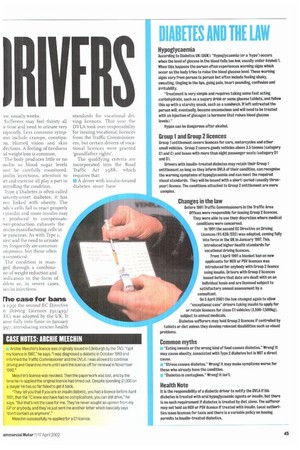DIABETES AND THE LAW
Page 45

If you've noticed an error in this article please click here to report it so we can fix it.
Hypoglycaemia
According to Diabetes UN (DUK): "Hypoglycaemia (or a 'hypo') occurs when the level of glucose in the blood falls too low, usually under dmmolil. When this happens the person often experiences warning signs which occur as the body tries to raise the blood glucose level. These warning signs vary from person to person but often include feeling shaky. sweating, tingling in the lips, going pale, heart pounding, confusion and irritability.
"Treatment is very simple and requires taking SOMA fast acting carbohydrate, such as a sugary drink or some glucose tablets, and follow this up with a starchy snack, such as a sandwich. If left untreated the person will, eventually, become unconscious and will need to be treated with an injection of glucagon (a hormone that raises blood glucose levels)."
Hypos can be dangerous after alcohol.
Group 1 and Croup 2 licences
Group 1 entitlement covers licences for cars, motorcycles and other small vehicles. Group 2 covers goods vehicles above 3.5 tonnes (category Cl and CI and buses with more than eight passenger seats (category D1 and Dl.
Drivers with insulin-treated diabetes may retain their Group 1 entitlement as long as they inform DVLA of their condition, can recognise the warning symptoms of hypoglycaemia and can meet the required visual standards. They will be issued with a short-period (usually threeyear) licence. The conditions attached to Group 2 entitlement are more complex.
Changes in the law
Before 1991 Traffic Commissioners in the Traffic Area Offices were responsible for issuing Group 2 licences. They were able to use their discretion where medical conditions were concerned.
In 1991 the second EC Directive on Driving Licences (91/439/EEC) was adopted. coming fully into force in the UN in January 1997. This
introduced higher health standards for vocational driving licences.
From 1 April 1991a blanket ban on new applicants for HGV or PSV licences was introduced for anybody with Group 2 licence using insulin. Drivers with Group 2 licences issued before that date are dealt with on an individual basis and are licensed subject to satisfactory annual assessment by a consultant.
On 5 April 2001 the law changed again to allow "exceptional case" drivers taking insulin to apply for or retain licences for class Cl vehicles (3,500-7,500kg), subject to annual medicals.
Diabetes sufferers may hold Group 2 licences if controlled by tablets or diet unless they develop relevant disabilities such as visual problems.
Common myths
Fr "Eating sweets or the wrong kind of food causes diabetes." Wrong! It may cause obesity, associated with Type 2 diabetes but is NOT a direct cause.
• "Stress causes diabetes." Wrong! It may make symptoms worse for those who already have the condition. "Diabetes is contagious." Wrong! It isn't.
Health Note
It is the responsibility of a diabetic driver to notify the DVLA if his diabetes is treated with oral hypoglycaemic agents or insulin, but there is no such requirement if diabetes is treated by diet alone. The sufferer may not hold an HGV or PSV licence if treated with insulin. Local authorities issue licences for taxis and there is a variable policy on issuing permits to insulin-treated diabetics.






















































































































































